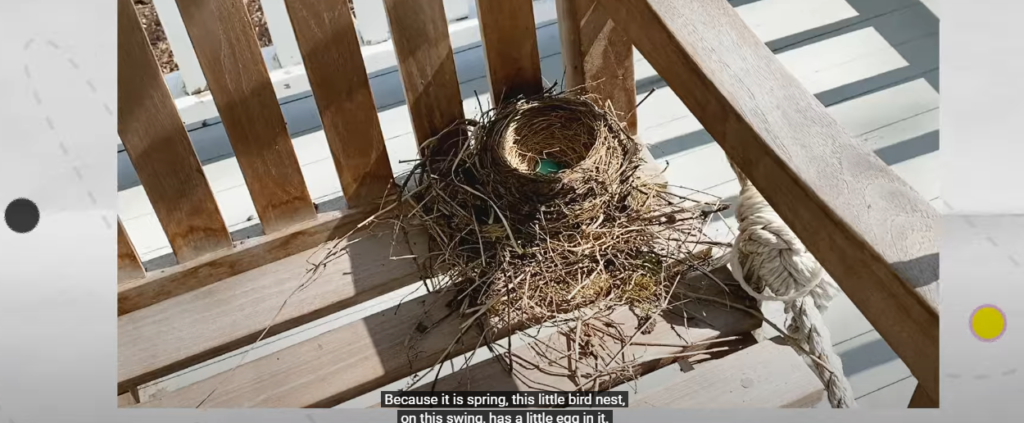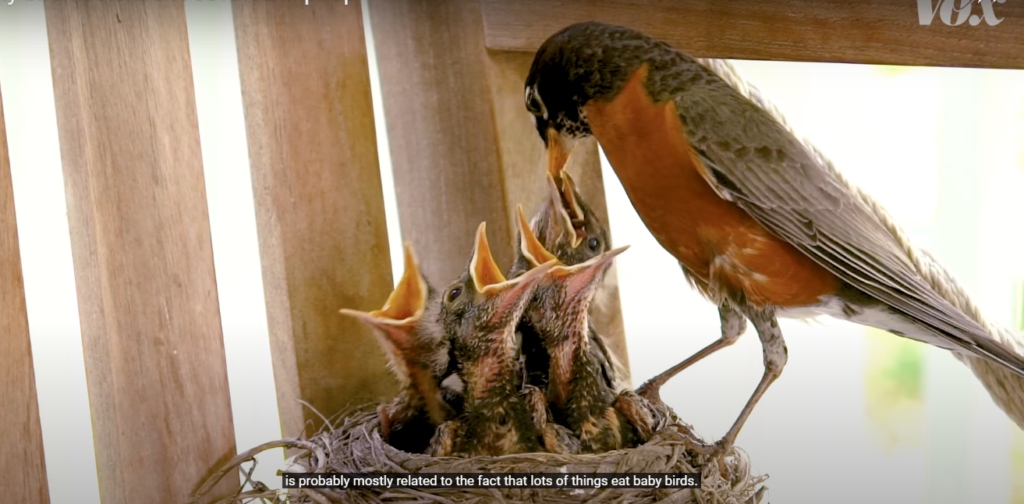Building a Robin Nests
American Robin Nests builders, with the male playing a key role in the process. He gathers nesting materials, which he presents to the female.
The female then constructs a cup-shaped nest, using mud as a base and weaving in grass, plant material, and other natural elements. Sometimes, the Robin Nests collect dry grass and dip it in water to help shape the nest.
The nest structure is primarily made of mud, which acts like cement, creating a strong foundation.Robin Nests gather mud from sources such as pond edges or earthworm castings, but during drier periods, they may need to be more resourceful.
They have been observed dipping their bills in birdbaths to collect water and then flying to dry areas to mix the mud for the nest.
Where Do Robin Nests Their Build?
Robin Nests are adaptable in choosing nest sites. They are found across Canada, Alaska, and most of the continental U.S., except for the warmer southern regions. Typically, robins build their nests on branches, ledges, and even in urban areas such as window sills or house eaves.
In addition to natural materials, Robin Nests often use human-made items like paper, flower petals, or string. While this may seem like decoration, these items serve a practical purpose by camouflaging the nest and helping it blend with the surroundings.
Read more: Where Do Robin Nests Their Build
Robin Migration and Nesting Patterns
While many robins migrate, they do not all travel long distances. In colder regions, robins tend to migrate south for the winter, while others may stay year-round, especially in more temperate climates. The nesting season typically begins in early spring, even when the weather is still cool.
As temperatures rise and food becomes more abundant, Robin Nests start to lay their eggs.
How Many Eggs Do Robins Lay?
On average, a female robin lays three to four eggs per clutch. However, robins can have multiple broods in a year, especially in warmer regions of the U.S. In the southern states, it is common for Robin Nests to lay more than one set of eggs annually.

Some robins may even lay eggs in the same nest multiple times, although finding an unusually high number of eggs, such as eight, may indicate that two females are competing for the same nest.
Interesting Facts About Robin Nests and Eggs
Robin Nests typically lay their iconic bright blue eggs, which are often a striking feature of their nests. In most cases, the eggs are laid in a small group, and the female will incubate them until they hatch.
Read more: Interesting Facts About Robin Nests and Eggs
A robin’s nesting behavior is a fascinating example of adaptation and resourcefulness, showing how these birds work to ensure the survival of their young.
In conclusion, American Robin Nests are remarkable in their nesting habits and adaptability. From their resourceful use of materials to their ability to thrive in both urban and rural environments, these birds continue to captivate those who observe their nesting behavior.
Color of American Robin Eggs
American robin eggs are easily recognizable by their vibrant, bright blue color. Unlike some other bird species, robin eggs do not have spots or markings. Their striking, solid blue hue is one of the key characteristics that make them stand out, especially when seen in the nest.

How Does the American Robin Nests Find Worms?
American Robin Nests are known for their excellent hunting skills, particularly when it comes to finding worms. They rely on their keen vision and exceptional hearing to locate prey.
Robins often spot worms by watching for movement on the ground, and they may also listen for the faint sounds of worms or insects beneath the soil. Once they locate a worm, they quickly hop forward and snatch it with their sharp beaks.
How Long Does It Take for a Robin’s Egg to Hatch?
The incubation period for robin eggs typically lasts between 12 to 14 days. During this time, the female robin incubates the eggs, keeping them warm while the male may help by bringing food. After the eggs hatch, the chicks are fed a diet primarily consisting of worms and insects, which the parents gather for them.
Also read: Hummingbird-feeder-maintenance-in-winterThe chicks grow rapidly, and within two weeks, they are usually ready to leave the nest.
Robin Nests Incubation and Hatching Process
Female Robin Nests typically lay their eggs over a period of about two weeks. Once the clutch is complete, the female begins incubating the eggs. The hatching process usually takes 12 to 14 days after the last egg is laid. During this period, the female spends most of her time incubating the eggs, ensuring they stay warm and protected.
It’s important to avoid disturbing a Robin Nests , as this can interfere with the natural hatching process.
Meaning Behind Robin Sightings
The sighting of a robin is often considered symbolic in many cultures. Robins are commonly associated with the arrival of spring, representing renewal, hope, and the start of new beginnings.
Some people view the appearance of a robin as a spiritual sign of guidance or reassurance, often linked to themes of love, transformation, and emotional healing.
Also read: Meaning-and-symbolism-of-the-hancock-birdDuration of Baby Robins in the Nest
After hatching, baby robins remain in the nest for about 13 to 14 days. During this time, both parents work together to care for the chicks, feeding them a diet primarily consisting of worms, insects, and berries.
Once the chicks are ready, they will fledge (leave the nest), though they may continue to rely on their parents for food and protection for a short period as they adjust to life outside the nest.
Do Robins Use Birdhouses?
While robins generally prefer to build their nests in trees, on ledges, or in other natural sites, they may occasionally use birdhouses if the conditions are right. However, robins tend to avoid confined spaces and prefer open, safe environments where they can easily watch for predators and access food.

Appearance of Baby Robins
Baby robins, or chicks, initially look quite different from their adult counterparts. At birth, they are small, naked, and dependent on their parents for warmth and food. As they grow, they develop a spotted breast rather than the characteristic reddish-orange plumage of adult robins.
The dark spots on their breast fade over time, and by the time they leave the nest, they resemble adult robins more closely.
Timeline of Robin Nesting
- Day 1: The female robin begins constructing her nest, a cup-shaped structure made of grass and other materials, with mud at the base.
- Day 8: The first egg is laid.
- Day 9: The second egg is laid.
- Day 10: The third egg is laid.
- Day 11: The fourth egg is laid, and the female begins full-time incubation.
During the first nesting of the season, robins typically lay 3 to 4 eggs. Some nests may have 5 eggs, but this is rare and can occur if another female robin lays eggs in the same nest. In subsequent nests, the number of eggs may decrease to 2 eggs per clutch.
Conclusion
The American Robin Nests is a fascinating bird with a well-defined nesting and hatching cycle. From building a nest to incubating eggs, and eventually raising their chicks, robins demonstrate incredible dedication to the survival of their young.
Whether through their vibrant eggs, their symbolic meaning, or their nurturing behavior, robins continue to capture the attention and admiration of bird enthusiasts and nature lovers alike.

